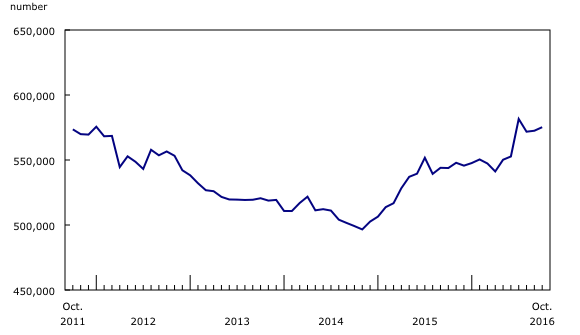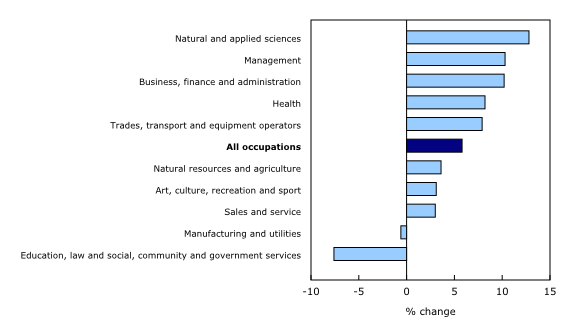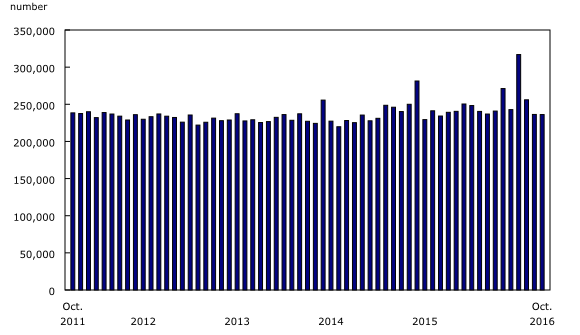Employment Insurance, October 2016
Archived Content
Information identified as archived is provided for reference, research or recordkeeping purposes. It is not subject to the Government of Canada Web Standards and has not been altered or updated since it was archived. Please "contact us" to request a format other than those available.
Released: 2016-12-20
In October, 575,200 people received regular Employment Insurance (EI) benefits, little changed (+2,700 or +0.5%) from the previous month.
The number of EI beneficiaries increased in five provinces, notably Saskatchewan (+6.0%), Alberta (+3.0%) and British Columbia (+2.1%), but also Newfoundland and Labrador (+1.9%) and Nova Scotia (+1.9%). On the other hand, the number of beneficiaries declined by 1.8% in Quebec.
Compared with 12 months earlier, the number of beneficiaries in Canada was up 31,400 (+5.8%).
In general, changes in the number of regular EI beneficiaries reflect various situations, including people becoming beneficiaries, going back to work, or no longer receiving regular benefits. In addition, part of the year-over-year increase could be related to EI policy changes that came into effect in July 2016. More information on the 2016 EI changes is available on the Employment and Social Development Canada website.
Provincial and sub-provincial overview
The number of regular EI beneficiaries in Saskatchewan increased by 6.0% to 21,200 in October. Both Saskatoon (+9.4%) and Regina (+2.1%) recorded increases this month, as did the rest of the province. On a year-over-year basis, the number of EI recipients in Saskatchewan rose by 39.1%.
In Alberta, 93,200 people received EI benefits in October, up 3.0%. Most of the increase was in Calgary (+4.3%) and Edmonton (+3.2%). In the 12 months to October, the number of beneficiaries in Alberta was up by 55.8%.
In British Columbia, the number of EI beneficiaries rose by 2.1% to 56,100. Increases were observed in Abbotsford–Mission (+8.3%) and Kelowna (+6.7%), while there was little change in Vancouver and Victoria. Compared with October 2015, the number of beneficiaries in the province was up 1.5%.
The number of EI beneficiaries in Newfoundland and Labrador increased 1.9% to 38,300 in October. Most areas of the province recorded increases, including St. John's, where the number of recipients was up 2.5%. Compared with 12 months earlier, the number of people receiving benefits in Newfoundland and Labrador was up 14.9%.
Nova Scotia had more people receiving EI benefits in October, up 1.9% to 28,800. There were increases in Halifax (+1.7%) and in other areas of the province.
On the other hand, the number of EI recipients in Quebec fell for the third consecutive month, down 1.8% to 138,100 in October. Decreases were generally observed throughout the province, with Montréal recording a decline of 1.2%. In the 12 months to October, the number of EI beneficiaries in Quebec was down 7.0%.
In Ontario, the number of EI beneficiaries decreased slightly, down 0.9% to 140,000. Most of this decline was in Toronto (-1.3%). There were also decreases in Barrie (-4.1%) and Kitchener–Cambridge–Waterloo (-3.1%). The province had 4.5% fewer EI beneficiaries than in October 2015.
Regular Employment Insurance beneficiaries by occupation
In the 12 months to October, all but two major occupation groups posted increases in the number of beneficiaries. The most notable increases were among those who last worked in natural and applied sciences and related occupations (+12.8%), management (+10.3%) and business, finance and administration (+10.2%).
Trades, transport and equipment operators—the occupation group with the most beneficiaries—had a year-over-year increase of 7.9% (+14,700). The increase was mainly in Alberta, Saskatchewan, and Newfoundland and Labrador, and was partly offset by declines in Quebec and Ontario.
In contrast, there were declines in the number of beneficiaries whose last job was in education, law and social, community and government services (-7.6%), and little change was observed in manufacturing and utilities.
Employment Insurance beneficiaries in major demographic groups
In October, there were more EI recipients aged 55 and older, and this was true for both men (+1.1%) and women (+1.5%). There were also more women aged 15 to 24 receiving EI benefits, up 3.0% from September. The other demographic groups showed little change.
The number of women receiving regular EI benefits has been on an upward trend since April 2016. This trend has been observed for all three age groups: 15 to 24, 25 to 54, and 55 and older.
Compared with 12 months earlier, the number of EI beneficiaries increased across all demographic groups. The most notable rise was among those aged 55 and older, with an increase of 12.3% for men and 10.1% for women.
Employment Insurance claims
Employment Insurance claims totalled 236,200 in October, little changed from the previous month. The number of claims provides an indication of the number of people who could become beneficiaries.
EI claims rose in Saskatchewan (+12.6%), Manitoba (+8.7%), Newfoundland and Labrador (+3.0%), and Alberta (+1.6%). On the other hand, the number of claims declined in New Brunswick (-5.4%), Prince Edward Island (-3.8%), Ontario (-2.6%), British Columbia (-1.6%), and Nova Scotia (-1.0%). There was little change in Quebec.
Compared with October 2015, EI claims were down 1.3% nationally, with a notable decrease in Quebec (-6.5%).
Note to readers
Concepts and methodology
Employment Insurance (EI) statistics are produced from administrative data sources provided by Service Canada and Employment and Social Development Canada. These statistics may, from time to time, be affected by changes to the Employment Insurance Act or administrative procedures. The most recent series of changes were introduced in July 2016.
Regular Employment Insurance (EI) benefits are available to eligible individuals who lose their jobs and who are available for and able to work, but cannot find a job. To receive EI benefits, individuals must first submit a claim. The number of claims provides an indication of the number of people who could become beneficiaries.
There is always a certain proportion of unemployed people who do not qualify for benefits. Some unemployed people have not contributed to the program because they have not worked in the past 12 months or their employment is not insured. Other unemployed people have contributed to the program but do not meet the eligibility criteria, such as workers who left their job voluntarily or those who did not accumulate enough hours of work to receive benefits.
All data in this release are seasonally adjusted. For more information on seasonal adjustment, see Seasonally adjusted data – Frequently asked questions.
Numbers in the Daily text are rounded to the nearest hundred.
The number of regular EI beneficiaries and the number of claims received for the current and previous month are subject to revision.
The number of beneficiaries is a measure of all people who received EI benefits from October 9 to 15. This period coincides with the reference week of the Labour Force Survey (LFS). However, initial and renewal claims data are for the entire month.
EI statistics indicate the number of people who received EI benefits, and should not be confused with LFS data, which provide information on the total number of unemployed people.
Geographical definitions
A census metropolitan area (CMA) or a census agglomeration (CA) is formed by one or more adjacent municipalities centred on a population centre. A CMA must have a total population of at least 100,000. A CA must have a population of at least 10,000. See Standard Geographical Classification 2011 – Definitions for more information.
Next release
Data on Employment Insurance for November 2016 will be released on January 18, 2017.
Products
More information about the concepts and use of Employment Insurance statistics is available in the Guide to Employment Insurance Statistics (73-506-G).
Contact information
For more information, contact us (toll-free 1-800-263-1136; 514-283-8300; STATCAN.infostats-infostats.STATCAN@canada.ca).
To enquire about the concepts, methods or data quality of this release, contact Gordon Song (613-793-2392; gordon.song@canada.ca), Labour Statistics Division.
- Date modified:






